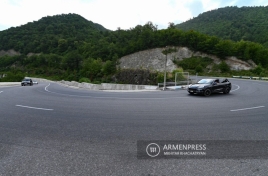Armenia Could Become a Multi-vector Transit Hub, Expert Comments on Accession to Ashgabat Agreement
Wednesday, May 21, 2025
The prospect of launching several transport projects simultaneously reflects the long-term vision of transforming Armenia into a transit hub, expert-researcher at the Amberd Research Center, Candidate of Economics and Associate Professor Anna Pakhlyan said in an interview with Armenpress, referring to Armenia’s decision to join the international transport and transit corridor under the Ashgabat Agreement.
– In your opinion, how economically expedient is Armenia’s accession to the Ashgabat Agreement? Are there any professional assessments regarding its benefits?
– Even without specific calculations, it is clear that for a landlocked and bilaterally blockaded country like Armenia, any opportunity to become part of interstate transport and transit routes is of vital and strategic importance. While Armenia’s accession to the Ashgabat Agreement, aimed at creating an international transport and transit corridor between Iran, Oman, Qatar, Turkmenistan, and Uzbekistan, may not bring immediate economic gains due to the limited volume of trade with these countries, it could enhance Armenia’s transit role. In this case, geopolitical significance prevails over economic expediency. Moreover, Armenia's limited production and export capacity does not currently support the level of cargo turnover needed to quickly recover the significant infrastructure investments required for full participation in the program.
– In your opinion, can this transit project be effectively combined with other regional connectivity initiatives, such as the North-South and Crossroads of Peace projects, given the existing disagreements among some of the countries involved in the Ashgabat Agreement?
– By and large, neither the North-South Transport Corridor nor the international transport and transit corridor envisioned by the Ashgabat Agreement can operate effectively for Armenia as long as there is no railway connection with Iran, and the main land route between the two countries faces significant accessibility, security, and infrastructure challenges.
The Ashgabat Agreement also envisions integration with the North-South International Transport Corridor, which includes road, sea, and rail routes, among them the Trans-Caspian Railway. The Trans-Caspian International Transport Route (TITR), also known as the Middle Corridor, runs through China, Kazakhstan, the Caspian Sea, Azerbaijan, Georgia, Turkey, and extends to European countries.
In essence, the section of the North-South Road Corridor passing through Armenia if fully operate after construction is complete, could serve as a link between the Ashgabat Agreement’s transit route and the corridor connecting Iran with Georgia and the Black Sea. This would allow Armenia to position itself as a multi-vector transit hub, facilitating routes such as Central Asia–Iran–Armenia–Georgia–EU/Black Sea or India–Persian Gulf–Armenia–Russia/Eurasia.
At the same time, many uncertainties remain regarding the Crossroads of Peace project. Its implementation depends largely on the progress of political processes involving Armenia, Azerbaijan, and Turkey. Skepticism is further fueled by the fact that that, over the past three decades, Turkey and Azerbaijan have invested huge resources so that international road infrastructure bypasses Armenia.
– Could Armenia's desire to join the Ashgabat Agreement indicate a shift in the country's economic orientation, or does it stem from the logic of diversifying economic ties?
– It is rather aimed at diversifying transport routes and does not reflect a change in economic orientation, especially since in some segments the routes coincide or are synchronized with other transport initiatives involving Armenia, such as the North-South Corridor and TRACECA. Ultimately, common sense suggests that the prospect of launching several transport projects simultaneously supports the long-term vision of turning Armenia into a transit hub. The real question is how feasible this will be, considering the disagreements between some of the countries participating in the international transport and transit corridor.
– Do you see any economic risks associated with joining this agreement?
– Of course, there are economic risks. Strengthening Armenia’s role as a transit country requires large-scale infrastructure investments, including the construction of roads, tunnels, railways, customs checkpoints, and more. Limited transportation volumes may not justify the costs.
Another important risk is overdependence on Iran. If the main route runs primarily through Iranian territory, Armenia could become vulnerable to geopolitical pressures, particularly in the context of Western sanctions. As a result, Armenian companies might face restricted access to Western markets or financial systems.
Published by Armenpress, original at https://armenpress.am/en/article/1220136





